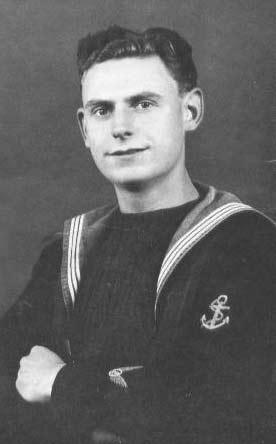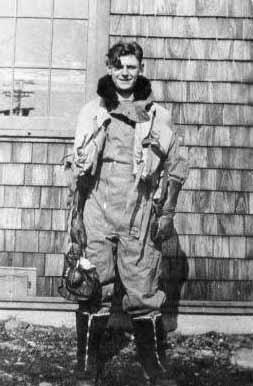
Remembering the Telegraphist Air Gunners

Fred Good (Telegraphist Air Gunner, Fleet Air Arm, Royal Navy)
Merchant Aircraft Carriers - MAC Ships
Merchant Aircraft Carriers, or MAC ships, played something of an unsung role in the
Battle of the Atlantic. In fact, Fred Good, a Telegraphist Air Gunner with the Fleet Air
Arm of the Royal Navy, readily admits that not many people are even aware of their
existence. However, the MAC ship provided vital air cover for a convoy and was used to
find and force down any submarine it encountered, and to attack and destroy any
submarine that refused to submerge. No U-Boats were sunk with the aid of the MAC
ships, but a submarine forced to dive and kept under was made impotent.
As a teenager Mr. Good couldn't wait to get involved in the Fleet Air Arm of the Royal
Navy. Thrilled at the prospect of joining his first ship, HMS Royal Arthur, he found himself
outside the gates of Butlins Holiday Camp in Skegness, where he was taken under the
wings of a group of tough, old, long serving matelots who taught him to heave a line, tie
a knot, wring out a swab and do a cross country march at the double. This was induction,
and he soon found himself in Canada undergoing flying training.
He was trained to be a Telegraphist Air Gunner and eventually received posting to an
operational squadron. Instead of joining a Fleet Carrier, however, he was sent to 836,
the MAC Ship Squadron. In the two short years MAC ships were in operation they helped
turn the tide in the Battle of the Atlantic and contributed to the final outcome.
MAC ships were introduced at a critical time when Britain was in real trouble. They were barely surviving in any field and as an Island
Nation they were on their knees. Since much of the population was devoted to the war effort, manufacturing and export was
insufficient. There was no national income and they had no choice but to import food and equipment from North America.
Of course, this meant crossing the Atlantic and forming huge convoys of merchant ships. Getting them across without loss to the
German U-Boats was a formidable tasks and the Atlantic was a disaster area. Much of the Atlantic sea- board was in German control,
which meant their reconnaissance planes could operate unhindered to observe and report on Allied movements. It was a fairly
sophisticated method used by the Germans, sending U-Boats into attacking positions using their diesel engines. As the convoy
approached they would switch to much slower battery propulsion, submerge and wait for their unsuspecting prey. After the attack,
they would then surface, switch back to diesel, increase speed to skirt past the convoy, and get into position ready for the next
attack. This also allowed them to air the boat, fix their position, communicate by radio and of course, recharge their batteries.
Their preferred hunting ground was out of reach of shore-based aircraft and was known as the
Atlantic Gap, approximately 950kms (600 miles) wide. What was needed to close the gap were
ship borne aircraft, which would keep the U-boats submerged. They would then be denied the
speed to catch up with, or get ahead of convoys, thereby avoiding the first and subsequent
attacks. Merchant ships were being destroyed faster than they could be replaced, and the
losses of Merchant Navy personnel was totally irreplaceable. On the other hand, the U-boat
fleet was growing. The use of Catapult-armed Merchant Ships in an effort to find some way of
hitting back had proved to be great value but at great expense, because each time an aircraft
was launched it had no way of flying to safety. So the brave pilots, after taking on the enemy,
had to take to their parachutes and hope to survive the freezing waters of the Atlantic for
long enough to be picked up. Survival time was estimated to be 5 minutes.
A solution was desperately needed. The answer offered was to fit a simple flight deck and
arrester gear to a suitable Merchant Ship. As an experiment a captured German ship, the M.V.
Hanover was converted and became HMS Audacity in June 1941, and so the MAC ship was
born. With no hanger, all aircraft maintenance had to be carried out in all kinds of foul
weather. The ship had 4 arrester wires and a crash barrier, and tests were so successful that
the Admiralty was convinced that this might be the answer they were looking for.
In 1942 the Admiralty placed an order for nine existing tankers to be converted plus six new grain ships and four new tankers to be
built. The first of these was commissioned in April 1943, a grain ship, the Empire MacAlpine. In all 19 MAC ships came into service
between April 1943 and April 1944. Their area of operation was the North Atlantic from Liverpool or Clyde to Halifax or New York and
they were manned by a Merchant Navy crew and Skipper with FAA ground staff and aircrew with Defensive Equipment Merchant
Shipping personnel manning a 4"stern gun and eight 20mm anti-aircraft cannons.
The convoy was arranged to leave a clear space in the centre rear, about 3miles by 1-mile, in which the MAC ship could turn into wind
for flying without endangering other ships. U-boat searches were flown off from this position whenever necessary from information
obtained from German message decoded by the Enigma machine. Searches were limited to 3 hours in the summer and 2 hours in the
winter especially when they were routed North.
Handling aircraft on a tilting, swaying deck took enormous physical and mental strength and starting up a 750 hp engine which had
been out all night, by means of a hand-wound flywheel inertia starter gave warming exercise to the whole body apart from the hands
which were grasping the steel and brass starting handle. And when that episode was over they couldn't go and lay down. MAC Ships
contributed greatly to convoy management. One can imagine how scattered a convoy could become after a severely stormy night,
with no means of ship to ship contact. These new weapons could round up the stragglers covering a far greater area much more
quickly than could an escort vessel such as a corvette or frigate, and this in turn conserved the fuel of the escorts They could also
signal the strays by use of the Aldis lamp, giving instructions about course and bearings.
The presence of MAC Ships was a great morale boost to the men of the Merchant Navy, and from their first voyage to the end of the
European war in May 1945, only two Merchant ships were sunk. The MAC ships didn't win the Battle of the Atlantic single handed but
if they had been conceived and introduced earlier it's a wonder how many Merchant Navy seamen's lives would have been spared. Mr.
Good's experience may have been unusual in that he didn't take any lives, but certainly as part of the MAC ships, he helped saved
many
Also read: Remembering WWII Veteran and Telegraphist Air Gunner Fred Good

copyright © Wartime Heritage Association
Website hosting courtesy of Register.com - a web.com company
Wartime Heritage
ASSOCIATION

Fred Good (East Camp, Yarmouth NS


- World War I - Menu
- WWI Stories and Articles
- Photos - Yarmouth Soldiers
- Selection of World War I Songs
- WWI Casualties of Yarmouth, NS
- Those Who Served - Yarmouth, NS
- WWI Casualties Digby Co. NS
- WWI Casualties Shelburne Co. NS
- Merchant Mariners (1915) Yarmouth, NS
- Canadian Forestry Corps - Non Yarmouth Birth/Residence Enlistments
- US Draft Registry - Yarmouth NS Born


- World War II - Menu
- WWII Stories and Articles
- Telegraphist Air Gunners
- WWII Casualties of Nova Scotia
- US Casualties with NS Connection
- Far East/Pacific Casualties with NS Connection
- Merchant Navy Casualties Nova Scotia
- Nova Scotia WWII Casualties Holten Canadian War Cemetery
- D-Day Casualties - Nova Scotia
- CANLOAN Program Casualties - Nova Scotia
- Battle of the Bulge Casualties - Nova Scotia
- WWII Casualties Yarmouth NS
- Yarmouth Casualties - RCAF RAF Canadian Army WWII
- Yarmouth Co., Marrages WWII
- Casualties Non-Born/Residents with Connection to Yarmouth Co., Nova Scotia.
- WWII Casualties Digby Co., NS
- Non-Nova Scotian WWII Casualties Buried in Nova Scotia
- WWII RCAF Casualties Aged 16-18
- Brothers/Sisters Who Served - World War II














